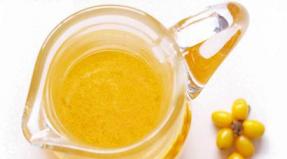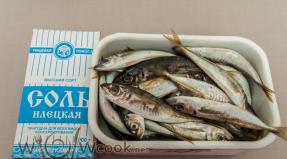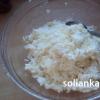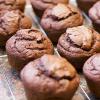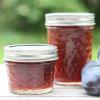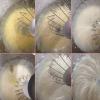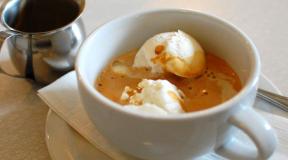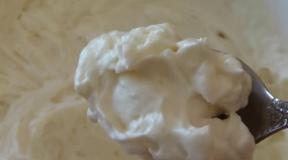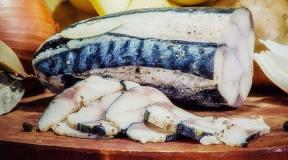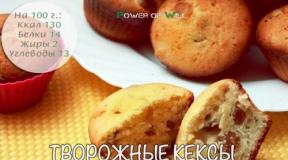Gingerbread dough: recipe. Gingerbread House Dough Recipe
Preparing for the Christmas holidays takes a long time. To delight the kids and add a festive mood, make your own gingerbread house. Get creative and decorate it with affordable products. Of course, you can buy ready-made blanks, but we will consider several options for independent "construction".
Gingerbread house - DIY step by step recipe
The whole process can be divided into several stages, each of which should be given enough time so that the result does not disappoint. It should be noted right away that the structure hardens quickly. Therefore, it is better to bake a gingerbread house just before a feast or use it only for decoration.
How to make a treat dough?
The finished cakes must keep their shape, so we will use shortbread dough. Stock up on a variety of spices right off the bat so that your festive Christmas house draws attention with its scents. There are two options for the finished test. Let's consider them in more detail.
1 way. For him we will take:
- 1 kg of bread flour;
- ½ tsp soda;
- 3 eggs;
- 200 g each sugar and butter;
- the same amount of honey;
- ginger, cinnamon, cardamom, cloves, allspice add ¼ teaspoons each.
First, using a mortar, grind all the spices. Add slightly warmed honey, granulated sugar, eggs and butter, which, if necessary, can be replaced with fatty margarine. Stir everything well.
Separately combine the baking soda with flour, and then, gradually adding to the spicy mixture, knead the dough. We put it in a plastic bag and send it to the refrigerator for several hours.
Method 2. The gingerbread house dough will be chocolatey. The only thing that will have to be changed is to leave only ginger and cinnamon from the spices and remove exactly 4 tbsp. l. flour, which in this recipe will replace cocoa. We prepare the dough in the same way as in the first version.
Glaze for a festive dessert
Glaze can also be used in 2 types. But the main thing is icing.



Prepare the following foods for cooking:
- 2 egg whites;
- 2 tbsp. l. lemon juice;
- 400 g icing sugar.
If you have the opportunity to bother the whole day in the kitchen, do not be lazy to make a gingerbread house with your own hands! This is an ideal decoration for the New Year's holiday and a great joy for little children, who, by the way, can be safely connected to the process.
Making a gingerbread house is a creative and exciting task! Gathering with the whole family, you can develop a design, come up with an interesting design, and just have fun. So, let's get down to the process and prepare a gingerbread house, following a step-by-step recipe with a photo!
Ingredients: 
For the test:
- butter - 120 g;
- honey - 200 g;
- ground ginger - 4 tsp;
- cocoa powder - 2 tbsp. spoons;
- ground cinnamon - 1 tsp;
- sugar - 100 g;
- baking soda - a small pinch;
- flour - about 300 g (how much the dough will take).
For caramel (gluing):
- sugar - 100 g;
- water - 40 ml.
For glaze:
- lemon juice - 1 tbsp spoon;
- egg white - 1 pc .;
- icing sugar - about 150-200 g.
For decor:
- colored caramel - 2-3 candies;
- chocolate pads - about 100 g;
- any confectionery sprinkles - optional.
New Year's gingerbread house recipe with photos step by step
- First of all, you need to cut out blanks for a gingerbread house from cardboard. You can find ready-made templates on the Internet or come up with a model yourself. In our example, we made blanks of the following dimensions:
- side walls - 2 pcs. (107x120 mm);
- roof - 2 pcs. (90x140 mm);
- facade - 2 pcs. (105x160 mm, while the wall height is 107 mm);
- base of the house - 1 pc. (150x210 mm).
- Also, do not forget to cut out the windows and doors on the facade and side walls. If you want to make a large house, the dough needs to be prepared 1.5-2 times more than indicated in the recipe.

- When the templates are prepared, we proceed to kneading the dough. Mix the softened butter with sugar and beat with a mixer until a soft and fluffy mass is formed. Add liquid honey and beat again.

- In a separate bowl, mix the dry ingredients: ginger, cinnamon, cocoa powder, baking soda and 100 g of sifted flour.

- Pour the dry mass into the butter in portions, stirring. Gradually add flour, knead the dough.

- The dosage of flour is adjustable when kneading: it may require a little more or less than indicated in the recipe. The dough should be non-sticky, soft and slightly crumbly. We roll it into a ball and send it to the refrigerator shelf for 20-30 minutes - after cooling, the dough will become more elastic.

- We roll out a thin layer on parchment paper, cut out parts of the future house using templates. We make sure that the thickness of the layer does not exceed 3 mm! If you make the layer thicker, the dough may remain loose inside, and the pieces will not be strong enough. In addition, the finished house can simply collapse under its own weight.

- Carefully transfer the parchment with the details to a baking sheet. We decorate the windows of the house with caramel. To do this, grind it into small crumbs, for example, placing it in a plastic bag and tapping it with a chop hammer. We spread the caramel chips in the "windows". When exposed to temperature, the caramel will quickly melt, and the windows will turn colored, as if a light was turned on in the house.

- We bake the components of the house for about 8-10 minutes at 180 degrees - do not overdo it! Freshly baked blanks will be soft at first, but then harden very quickly.

- We collect dough scraps and bake cookies using molds in the form of Christmas trees, deer, men, etc. By the way, ready-made cookies can also be used in decorating a house.

- When all the constituent parts are completely ready, we proceed to the "assembly" of the gingerbread house.

- We will glue the parts of the house with caramel. To prepare it, pour sugar into a refractory dish with a thick bottom and add drinking water. While stirring, bring to a boil over medium heat.

- Continuing to stir, cook the sweet mixture until golden brown. To check the readiness, we take a small amount of syrup and put it in a container of cold water. If a hard caramel forms after a couple of seconds, the syrup is ready!

- Now we proceed to the most crucial stage. Gently, so as not to burn yourself, we dip the parts of the house with their butt ends in hot caramel and quickly fasten together. First, we glue the side wall and the facade, attach to the base.

- Then we attach the second side and the back wall of the house. You need to work quickly, since the caramel freezes very quickly. At this stage, it is better to get an assistant, since it will be difficult to fasten the house alone. So that the still unused caramel in the dishes does not solidify, it is better to cover it with a lid and periodically warm it up over minimal heat.

- Last but not least, we fix the roof. We leave the formed house for about an hour.

How to make gingerbread house frosting
- Mix the cooled raw protein with lemon juice. Beat until white foam is obtained.

- Pour sweet powder in portions, without stopping to work as a mixer. As a result, the whites need to be whipped into a cool mass, otherwise the icing on the house will not solidify. Increase the powder dosage if necessary.

- Put the glaze in a plastic bag and cut off the tip. We carefully process the gluing points to hide traces of caramel. Apply glaze to the roof and then attach chocolate pads to simulate shingles. On request, we supplement the house with any pastry sprinkles. Also icicles can be formed with glaze. If the consistency of the glaze is correct, they will hold their shape well and harden quickly.

Congratulations! You made a gingerbread house with your own hands! Unfortunately, gingerbread dough quickly turns stale and tough. Therefore, if you want to have a tea party, it is better to do it immediately after preparation, or just leave the house as a decoration. We wish you pleasant and happy holidays!
» For dough preparation need viscous honey. If you have crystallized honey, then it must be placed in a warm place (for example, on a battery) and allowed to melt, or heated in a water bath.
» Gingerbread house can be stored up to 1 month, so it can be done in advance.
» Can be distributed house preparation stages: dough, baking, painting, assembly. All these tasks can be performed on different days, then the preparation of the house will not seem like an overwhelming task.
» For creating snow effect the house can be powdered with powdered sugar.
» The chimney can decorate any nuts - they will imitate masonry.
» Can be dispensed with without gluing parts... It is enough to draw out every detail of the house on paper in a cage, but from each edge of the frontal parts retreat 1.5-2 cells from the side and 1.5-2 from the bottom, drawing up "grooves" 1-2 cells wide (roll the dough half thinner than the width of the groove ). Make the side parts wider than the joints - by 1-2 cells. If the house is one-story, the frontal details are combined square with a triangle, 2-3 floors - a rectangle with a triangle. For the roof of the house, at the very top of the triangle of the frontal parts, make a hole wider than the skewer on which the roof will be reinforced. Cut the roof in one piece (the finished roof piece bent in a triangle should be wider at the edges than the walls of the house). It is easy to bake the roof already in a triangular shape, if you make a triangle of the desired shape from several layers of foil covered with parchment and place the dough on top. The finished house will only have to be assembled (insert into the grooves on the frontal parts - the side walls, insert a skewer / toothpick into the holes in the top of the triangles of the frontal parts and place the roof on top), decorate the house with sugar mastic and confectionery beads. Joints of matching parts - decorate with nuts, sticking them on mastic or chocolate. Pipe, shutters - to mold from marzipan or Mamba candies, attaching to mastic. If you make windows from melted candies, and put a mini-light bulb powered by a mini battery inside the house, it looks very beautiful.
» Gingerbread dough- only custard, sugar is excluded, as well as molasses. Sour cream 20%, soda - in no case. If sour cream is not enough for a fluffy dough, add three dessert spoons of brandy or vodka. Spices are a must, but not in excess - "overpower" the aroma of honey dough. Chopped nuts are possible, but they make the dough “heavier”, preventing it from “rising”. Grind lightly toasted almonds into powder. If the dough is not kneaded with great care, the additives will start to burn. Do not mix cinnamon into the dough - it is good for sprinkling. The icing is easy to make from powdered sugar with orange or lemon juice, cranberry or kiwi. Children are not very fond of dough, they prefer designer confectionery finishes. If adults are not ready to get enough of honey gingerbread, make a house based on the classic "Anthill", gluing sand "logs" with condensed milk with nuts. Lithuanian cake "Shakotis" is an excellent "packaging" for a bottle of Riga black balsam or Vanna Tallinn balsam.
» The roof can be done with less effort. To do this, roll out the dough thinner than for the walls, or remove the excess from the baked piece. Objectively, glaze with protein alone is not enough. Especially if you are making a house for the first time. Note that you still have gingerbread dough left over, so use 2-3 proteins better, you can't go wrong.
The wonderful tradition of making a gingerbread house with your own hands before the New Year and Christmas holidays came to our country not so long ago from Europe. The art of creating these edible architectural masterpieces originated in Germany in the 19th century and quickly gained popularity, spreading to neighboring European countries. Gingerbread houses not only became a must-have festive decoration for people's homes, but also firmly settled in Christmas markets and special exhibitions, where you could even get some nice prize for them. So, for more than 20 years in the charming Norwegian town of Bergen, shortly before Christmas, a real gingerbread city has opened, for which the locals create edible exhibits of amazing beauty and originality.
An important prerequisite for the emergence of the culture of gingerbread houses was the creation in the Middle Ages of a special type of dough, the products of which did not dry out for a long time and remained edible even a couple of weeks after baking. Gingerbread dough and making houses from it allowed people not only to decorate their homes for the holidays, but also later enjoy these delicious decorations to the delight of all family members, young and old. In addition, this is a very aromatic, plastic and very easy to prepare dough, which is a real pleasure to work with both for a beginner and an advanced cook.
Today I want to tell you in detail how to make a gingerbread house with my own hands, be sure to involve my friends, children and other family members in this exciting business. There is nothing particularly difficult in making a house, and I will try to reveal all the secrets and possible pitfalls of this process so that you can easily create your own unique and inimitable culinary and architectural masterpiece. A homemade gingerbread house can be a wonderful element of New Year's decor in your apartment, as well as go to a school exhibition or charity Christmas market. At the end of the holidays, you can even arrange a ritual eating of the house, although personally I would not risk encroaching on my own work of art. But just in case, I would advise you not to store it for more than two weeks before eating it.
Be sure to try making a gingerbread house at home with your family and friends. This is a great holiday pastime that will help you and your children develop their imagination and unleash their creativity, and in addition, it may well become your new family New Year's tradition!
How to make a gingerbread house with your own hands:, and,
INGREDIENTS:
- 420 g flour
- 150 g honey
- 80 g sugar
- 1 pack. vanilla sugar
- 90 g butter
- 2 small eggs
- 1 tsp baking powder
- ground spices: 1/2 tsp cinnamon, 1/2 tsp. ginger, 1/2 tsp. cardamom, a pinch of cloves, a pinch of nutmeg
Glaze No. 1:
- 1 egg white
- 100 g icing sugar
- 1 tsp lemon juice
Glaze No. 2:
- 1 egg white
- 200 g icing sugar
- 1 tsp lemon juice
Decorations:
- colored sprinkles
- multicolored dragee
- coconut flakes
COOKING METHOD:
1. In order to make a gingerbread house with your own hands for the New Year, first we knead a delicious and aromatic gingerbread dough for it. To do this, put sugar, honey, vanilla sugar and diced butter in a small saucepan.
2. Heat the honey mixture over low heat, stirring occasionally, until all the components combine into a thick homogeneous mass. Do not bring the mixture to a boil, as honey will lose its beneficial properties. 
3. Cool the mixture for 10 - 15 minutes until slightly warm, then add eggs and ground spices to it and mix thoroughly. 
4. Pour the honey mixture into a deep bowl for kneading the dough and gradually, in 2 - 3 doses, add flour sifted with baking powder into it. 
5. Knead the dough thoroughly until smooth with your hands or in a food processor using the hook attachment. The gingerbread dough should be tight, not sticky at all and easily gather into a lump. 
6. Gather the dough into a lump, wrap it in plastic wrap and refrigerate for at least 2 hours or even overnight.
For the convenience of rolling, I divided the gingerbread dough into 2 parts and gave them the shape of flat rectangles. But you can store the dough in one large ball. If the dough has been in the refrigerator for several hours, it is better to take it out 20-30 minutes before working with it in order to simplify the rolling procedure.

Template for a gingerbread house
7. In the meantime, you need to cut out the templates for the gingerbread house from thick cardboard. You can cut windows and doors into them in advance, but I did it on the already rolled out test "by eye". In addition, the windows can not even be cut out at all, but painted on the walls of the house with protein glaze.

8. Roll half of the gingerbread dough on a floured surface into a layer approximately 5 mm thick.
Important! When rolling, keep in mind that the dough will slightly increase in size during baking. It should not be too thin, otherwise you will get a fragile house structure, but too thick walls will be difficult to fix together.

9. Attach cardboard templates to the dough and cut out the details of the house. Transfer them to a baking sheet lined with parchment and lightly sprinkle with flour on top. 
10. Bake in an oven preheated to 180 ° C on the lower shelf for 10 - 12 minutes. The dough for the gingerbread house should not brown, as soon as it begins to golden around the edges, it must be removed from the oven. 
11. Roll out the remaining dough, cut out of it and bake a base for a house of arbitrary shape and other details for decorating the entire installation, which your imagination will tell you - a chimney, a bench, Christmas trees, etc. You can make gingerbread from the remains of the dough, bake and eat them right at the checkout 🙂 
12. While the details of the house are cooling down, you should prepare protein glaze No. 1 to decorate the house. To do this, beat the cooled egg white at high speed of the mixer into a foam, gradually adding powdered sugar. 
13. Whisk the mixture vigorously for 2 - 3 minutes and add lemon juice at the very end. You should get a thick but flowing protein glaze. 
Decorating and assembling a gingerbread house
14. Pour the glaze into a pastry bag with a fine nozzle and decorate the house of your choice with it. You can circle windows, doors, draw roof tiles, etc. 
15. While the glaze is not dry, you can stick various decorations on it - colored confectionery sprinkles, multi-colored M & M’s dragees, and sprinkle the details with coconut flakes that imitate snow. After that, it is necessary to allow the glaze to dry completely for several hours, otherwise it may smear or leak when installing the parts of the house. 
16. To fasten the parts and install the house, you should prepare protein glaze No. 2 with an increased amount of powdered sugar. It is thicker and more sticky and dries faster, allowing better fixation of all joints.
The first step is to install two adjacent walls of the house on a base baked from dough or some other surface (plate, tray). The white glaze should be applied with a pastry bag to the surfaces that bond to each other, as well as to the base for the house. Having installed the walls, you can hold them for some time with your hands until the glaze hardens, or you can support them on all sides with suitable sized objects. In addition, to make the walls smoother and perpendicular to each other, you can insert a rectangular object inside the house.
Advice! If you see that the joints of the house parts do not fit together very well, for example, due to their deformation during the baking process, then you can file them slightly with a knife for a more accurate and convenient fit to each other.

17. Next, you must immediately install the other two walls of the house and wait for them to be firmly fixed for about an hour. To prevent the white glaze remaining for the roof from drying out during this time, cover the bowl with it with a damp towel. 
18. At the last stage of assembling the house, you need to attach two parts of the roof in turn, generously smearing the joints with protein glaze.
Advice! In the process of assembling a gingerbread house, some problems may arise, for example, glaze leaking out where it should not be, or, conversely, a lack of glaze in some places. Spilled glaze can be easily tweaked or removed with a cotton swab, or brush into crevices or other necessary areas with a brush.

After the house is completely assembled, you can additionally decorate it or correct imperfections with the remaining protein glaze. In addition, you can decorate the base for the house with glaze and sprinkles, as well as glue and attach the remaining parts - a chimney, an entrance door, a bench, etc. Here, the scope for your imagination is practically unlimited.
A cozy and elegant gingerbread house, made with your own hands with the help of relatives and friends, will create a New Year's mood and become the best home decoration for the upcoming holidays! 
In the old days, gingerbread was cooked only with honey.(natural mixture of sugars fructose and glucose), because sugar (sucrose) and molasses (starch processing product) did not exist at that time. Nowadays, gingerbread cookies can be sugar, sugar-honey and honey.
After 2-3 weeks, the gingerbread cookies become stale and not tasty.
Honey gingerbread, in which only honey is used in the absence of sugar and molasses, are still the best gingerbread; they are not only the tastiest, but also the most persistent in storage. Consider this when preparing your homemade gingerbread products.Making gingerbread dough is extremely easyit consists in simply mixing all the components included in the recipe, most often simultaneously, sometimes (in custard cakes) twice - in two steps. However, mixing the gingerbread dough into a homogeneous mass must be extremely careful. The dough should be well rinsed, especially in large pieces (several kilograms), and then it should be allowed to “rest” a little, but no more than 15 minutes.The best real gingerbread -custard gingerbread, they are prepared from custard gingerbread dough, which is prepared in two steps; simpler to prepare, but significantly inferior in taste and shelf life -raw gingerbread, for which the dough is prepared in one step, which is convenient for industrial production. Making any gingerbread dough at home is always very simple - after allgingerbread dough is one of the easiest to prepare; the main thing is to stir it well and rinse it. Of course,only custard gingerbread should be cooked at home.
You can't make a good gingerbread without honey.
1)
Thinking over the construction and design of a future house or palace, or castle, or an unprecedented fantastic structure.
2)
Construction design. Drawing of all the gingerbread parts on a 1: 1 scale with a pencil on thick paper (Whatman paper) or cardboard.
3)
Cutting paper or cardboard templates from ready-made drawings with scissors.
4)
Cooking gingerbread dough, rolling it into layers to the desired thickness.
5)
Cutting out all the gingerbread parts from the dough layers with a knife according to the superimposed templates.
(From the remaining scraps we make small gingerbread cookies, which we bake together with the details.)
6)
Baking the carved gingerbread building parts.
7)
Cooking sugar fondant for gluing together parts when assembling a house.
8)
Assembling the house by gluing the parts with hot sugar fondant.
9)
Preparation of icing, pastry mastic, etc., necessary for decorating a house.
10)
Decorating the assembled gingerbread house according to your own exquisite taste and using all your unbridled artistic imagination.
Previously, candles were often placed in gingerbread houses so that the windows glowed in the dark.
Nowadays, it is recommended to place a small flashlight in the house, loosely wrapped in a thin cloth for light scattering.
It is better if this fabric is yellow or orange.



- real gingerbread dough is prepared only with honey and sour cream(no added sugar or molasses and no artificial leavening agents);
- in all cases, to obtain a good gingerbread opening, add 4 tbsp. spoons vodka, brandy or rum for 1 kg of flour;
- if instead of honey you have to use sugar (sucrose), try to replace it in the same amount with natural natural sugar fructose(fruit sugar); - for real gingerbread, take only butter(but not margarine or vegetable oil);
- real gingerbread dough should only be custard(not raw);
- gingerbread icing should only be real(cooked with whipped egg whites, not water, and preferably not sucrose, but fructose).
It is even better to glaze the gingerbread cookies with honey boiled to a caramel state, mixed during boiling with a small addition (about 10%) of any acidifier (juice of cranberries or other sour berries and fruits, lemon, etc .; or you can add a little strong citric acid solution ) Is the ancient traditional way and it is the best. - Very good results are obtained by adding various powdered dried berries to the gingerbread dough, as well as finely grated nuts - experiment with their additions, and your gingerbread cookies will surpass all others in taste!
You can also add finely chopped with a knife (or minced) to the gingerbread dough dried fruit(raisins, dried apricots, dates, prunes, etc.) - the gingerbread will be even tastier.
Surprisingly, reduced-grade flour produces the best results in gingerbread. - Any gingerbread is flavored with herbs or mashed spices. This is an important part of the preparation.
DRY SPIRITS- Russian confectionery designation for a set of spices used in confectionery production, especially in gingerbread.
The dry perfume includes (according to Pokhlebkin): cinnamon, black pepper, allspice, star anise, cloves, anise, ginger, coriander, lemon and orange peel, calamus, nutmeg, nutmeg, vanilla.
Typical of a good gingerbread dough is a whole mixture of spices: cloves, cinnamon, ginger, anise, coriander, cardamom, nutmeg, some black pepper, paprika, and salt are all crushed into a powder.
Pounded bitter almonds, lemon and orange peel are also added.
Dry perfumes (flavoring and aromatic additives) are laid at the stage of kneading the dough so that they properly saturate the gingerbread dough with their smells.
You can use the compositions proposed below or come up with your own signature one - the main thing is that the prepared spices are pleasant to you in the finished and mixed form.
If any component seems inappropriate or you just don't like its smell, change it as you see fit.
- 35% coriander,
- 30% cinnamon
- 10% cardamom,
- 10% nutmeg,
- 5% cloves,
- 5% star anise,
- 5% allspice
Usually 1-2 tsp are added to 1 kg of gingerbread dough. mixture, necessarily crushed into the finest dust.
(how much of this mixture to put in the dough - this is decided according to your own taste, i.e. for the first time we just add a little bit, smell and taste the dough, during the next preparations we put it according to our own experience)
- as additional elements in the gingerbread dough, you can add pounded zest of lemon, orange, roasted and then grated nuts (for example, walnuts), a little vanilla.
All components must be thoroughly ground into dust and kneaded into the dough when it is still quite liquid.
Good results are obtained with an additional addition of 1-2 tbsp. spoons of good brandy or rum per 1 kg of flour. Or part of the water can, to taste, be replaced with good fortified wine (sherry, port, nutmeg, tokay, various dessert wines).
SOME MORE OPTIONS OF GINGERBREAD DRY PERFUMES
These and other variants of gingerbread mixtures are used mainly in the confectionery industry, where 1-2 teaspoons of powder are used per 1 kg of dough.
1st OPTION (in teaspoons):
- cinnamon - 4,
- star anise - 2,
- nutmeg - 1,
- ginger - 1,
- Jamaican pepper - 1,
- orange peel - 1,
- nutmeg color - 1/2,
- anise - 1/2,
- black pepper - 1/2.
2nd OPTION (in teaspoons):
- star anise - 3,
- anise - 2,
- cinnamon - 2,
- ginger - 1,
- lemon zest - 1,
- cloves - 1/2,
- nutmeg - 1/2,
- cardamom - 1/2.
3rd OPTION (in teaspoons):
- cinnamon - 4,
- star anise - 2,
- nutmeg - 1,
- ginger - 1,
- cardamom - 1/2,
- cloves - 1/2,
- lemon zest - 1/2,
- orange peel - 1/2,
- orange zest - 1/2,
- black pepper - 1/2,
- Jamaican pepper - 1/2.
NOTE.
Confectionery spice mixtures are used in many types of baked goods.
Typically, they include in various forms such spices as anise (cookies, gingerbread, gingerbread); star anise (cakes, cookies, muffins, gingerbread); vanilla (all baked goods, cream, cakes, curd products); cloves (gingerbread); oregano (pizza); ginger (cookies, gingerbread, candies, marmalade, jelly; an essential component of "dry perfume"); cardamom (cakes, cookies, honey cake, gingerbread, yeast dough pies); coriander (bread, cookies, gingerbread, gingerbread); cinnamon (cookies, rolls, biscuit, gingerbread, gingerbread); lemon balm (cakes, pastries); nutmeg mixed with cinnamon, cloves, cardamom, star anise (gingerbread, gingerbread, cookies); black pepper (gingerbread); allspice or Jamaican pepper (gingerbread; part of "dry spirits"); caraway seeds (bread, cookies, gingerbread cookies, buns, bagels, cheese sticks, cheese and feta cheese biscuits); saffron (as a flavoring and yellow coloring for cakes, muffins, rum babies).
Baking powder for dough. Good results are obtained by replacing baking soda with ammonium carbonate or a mixture of soda and ammonium 1: 1 (baking powder). Soda slightly changes the taste of the dough and does not change its color; ammonium does not give the dough any aftertaste, but gives the eggs included in the dough a slightly greenish color (this is completely harmless, and the dyed dough is invisible).
If it was not possible to find rye flour or it is not provided for in the recipe, then you can tint the dough:
- burnt sugar (burnt sugar) - burnt sugar is added in the form of a thick syrup along with spices to a still batter;
- grated chocolate or cocoa powder;
- various dry berries crushed into a fine powder (berry coloring is the best option).
All coloring additives are added at the beginning of the dough kneading.
A filling for gingerbread (not to be confused with a layer) can be thick fruit jam, jam, jam well strained from the liquid, as well as marzipan or nuts passed through a meat grinder, thoroughly mixed into a thick mass with whipped proteins with sugar. It is useful to add a small amount of good cognac to the filling.
The filling is put into the products before baking in a thin even layer and carefully pinch the edges of the dough until it is completely sealed.
When making printed gingerbread cookies with a filling, a layer of dough is laid in an oiled gingerbread mold, then the filling is applied (make sure that the filling does not fall on the edges), closed with a second layer of dough and everything is carefully pressed into a mold for good printing of the relief (when making large gingerbread cookies, a press is used ). Then the form is tipped over, the gingerbread is released and sent to baking.
When baking parts for gingerbread houses, the filling is usually not used. For large gingerbread houses, assembly parts can be sandwiched by gluing them together from 2 or more baked thin layers (6-8 mm thick), then the edges of the glued part can be trimmed with a knife (the resulting cuttings can be chopped and used for decoration).
Gingerbread products should be baked well, but should not be baked for a long time, otherwise their taste deteriorates - gingerbread dough is one of the fastest baking.
• Store gingerbread in a cool, well-covered place.
It is best to store the gingerbread cookies in a wooden or metal box, in which several slices of apple are placed - then they do not stale for a long time, retain their taste and aroma well.
ADVICE. If the gingerbread cookies are dry, they can be grated, mixed with a mixture of condensed milk and butter softened at room temperature (1: 1 in volume) and make delicious Potato cakes (it is advisable to add a little brandy to the mixture).
Gingerbread dough recipe
|
Products |
Number of products for dough |
|||||
|
honey |
sugar |
honey-sugar |
||||
|
Flour, tea glasses (250 ml) |
||||||
|
Granulated sugar (fructose desirable), tea glasses |
||||||
|
Honey, tea glasses |
||||||
|
Butter (or margarine), g |
||||||
|
Soda, teaspoons |
||||||
|
Chopped spices, teaspoons |
||||||
|
Water (or kefir, yogurt, fermented baked milk), tea glasses |
||||||
|
The output of the baked piece, g |
||||||
Depending on the sugar and honey content, the main gingerbread dough has three varieties: honey dough, sugar (without honey) and honey-sugar.
The dough can be prepared in two ways: raw and custard.
· Gingerbread made from raw dough dries quickly and hardens.
Choux pastry gingerbread is much tastier, stay fresh and aromatic for a long time
IMPORTANT NOTE FOR HONEY TEST:
Real gingerbread cookies are prepared without chemical leavening agents (without the addition of soda, ammonium carbonate, etc.).
Cooking gingerbread dough only on honey (without sugar or molasses) with the addition after brewing and cooling of the dough, thick (fat content not less than 20%) sour cream, 100-300 g per 1 kg of flour (the amount of sour cream is selected according to the resulting dough consistency) does not add a baking powder the right one.
In combination with honey, sour cream gives a slight fermentation, accompanied by slight gas formation, moderately, almost imperceptibly, loosening the dough. It is this slight loosening that creates the special consistency of real gingerbread dough.
For additional loosening, it is always useful to add 4 tablespoons of flour to 1 kg of flour. spoons of vodka or brandy, rum.
The addition of soda to such a dough will not allow the "gingerbread" sour cream-honey fermentation to go.
The main thing is that any gingerbread dough should be thoroughly rinsed until the products are evenly distributed in it, i.e. until complete homogeneity is achieved.
Kneading the dough actively with your hands can take from 10-20 to 40 minutes.
The better the dough is rinsed, the softer and more fluffy the gingerbread will be.
Choux pastry preparation(this is the only way to make real gingerbread!)
Put honey, sugar in a saucepan, pour water and heat to 70-75 ° C, add half sifted flour and finely grated spices and mix quickly with a wooden spatula or strong spoon.
If, after pouring flour into hot syrup, leave it unmixed for 1-2 minutes, then lumps will form, which will be difficult to stir.
The kneaded dough must be thoroughly cooled to room temperature (so that no warmth can be felt in it! - this is important), only then add eggs, fatty sour cream (from 100 to 300 g per 1 kg of flour - according to the consistency of the dough) or baking powder, flour residues and knead until a soft dough is obtained (depending on the amount of dough, knead vigorously for 10-20-40 minutes).
The finished dough should be plastic, not very sticky to the table, to your hands, and easy to form.
The washed dough should be immediately cut and baked, otherwise it will drag on and the products will turn out to be of poor quality.
Raw (simplified) dough preparation
(this method is undesirable, although it is often used)
Put honey in a bowl or saucepan, add pre-crushed butter, eggs, spices and mix everything for 1-2 minutes, then add flour sifted and mixed with soda and knead the not very tough dough.
If the honey is candied, it is heated until the crystals dissolve. Honey should not be boiled, as this will cause it to lose its aroma. After heating, the honey is cooled to room temperature and the dough is kneaded as described above.
In the manufacture of sugar gingerbread, sugar and water are brought to a boil, remove the foam with a slotted spoon, put butter in the syrup, stir and cool the syrup to room temperature. If the syrup turns out to be liquid, boil it down to test it on a thick thread. In the cold syrup, stirring, add spices, eggs, and then flour mixed with soda.
About acceptable changes in the recipe
It is possible, but highly undesirable, to replace cow oil with margarine or vegetable oil, since it is not very sensitive in gingerbread. You can cook the dough with a doubled amount of fat (including by adding fatty sour cream) or without fat. Gingerbread without fat will, of course, taste worse than with fat.
You can also give twice as many eggs in the dough or not at all, changing the dosage of water accordingly.
If sugar (sucrose) is used in a recipe, it is always advisable to replace it with the same amount of fructose (fruit sugar).
Gingerbread is usually made with first grade wheat flour, but you can also use second grade flour, and the gingerbread will be slightly darker. For certain types of gingerbread, premium flour is desirable, which is indicated in the corresponding recipes; you can make gingerbread cookies from rye baked flour or from a mixture of wheat (2 cups) and rye (1 cup).
The amount of flour can vary depending on the thickness of the syrup or honey, the amount of fat and eggs.
You cannot knead very steep dough, as it will rise poorly and the finished products will turn out to be unsatisfactory in appearance, and to taste - tough. A very soft dough is difficult to shape, it spreads during baking, and the gingerbread turns out to be shapeless and without a pattern.
The finished dough should be plastic, not very sticky to the table, to your hands, and easy to form. Baking soda can be substituted for ammonium carbonate, but it is best to take the same amount of soda and ammonium, this will weaken the taste of alkali and the smell of ammonia in the finished gingerbread.
Dough aromatization and coloring
Gingerbread cookies made with honey have a strong honey aroma, so they need to be slightly scented. Gingerbread without honey needs to be flavored much more. Finely ground dry spices are added as aromatic substances. For the spice mixture, take 35% coriander, 30% cinnamon, 10% cardamom, 10% nutmeg and 5% each clove, star anise and allspice. You can change the ratio of spices to taste. In addition, for aroma and taste, you can add another 1/2 cup of shelled roasted chopped nuts, peanuts or almonds, candied fruit, lemon or orange zest and 5-10 g of vanilla sugar.
If the gingerbread is made from dark varieties of honey and dark varieties of flour, then you should not tint the dough. Gingerbread cookies cooked in sugar or from light varieties of flour and honey should be tinted with burnt sugar (burnt) until light brown.
Burnt beef is added to the syrup at the beginning of the batch.
It is even better to tint the dough with an additive at the beginning of the kneading of various dry berries, ground into powder (choice of berries according to taste and availability).
You can tint the dough by adding cocoa powder or slightly warmed up in a water bath until dark dark chocolate softens (65% cocoa and above).
Cutting and baking gingerbread dough
The finished dough is placed on a flat board or table. To prevent it from sticking to your hands and to the board, sprinkle flour on the board and dough. They form the dough in the form of a brick by hand, put it on a floured board, sprinkle it with flour on top and roll it out into an even layer 5-8 mm thick with a rolling pin. When making a gingerbread, the prepared layer 10-12 mm thick can be rolled onto a rolling pin and put on a baking sheet.
If gingerbread or biscuits are prepared, then the finished layer of dough is cut with a knife or with the help of grooves into all kinds of figures. The weight of one gingerbread, depending on the size of the groove, can vary from 20 to 40 g. Certain varieties of gingerbread, for example, Tula loafs, can weigh up to 100 g.
Gingerbreads are gingerbread products that differ from piece gingerbread in large sizes. The rug is usually a large baked layer with or without filling and decorations, which is cut into pieces when finished.
Cool gingerbread dough can be put for baking on a clean, washed baking sheet without grease, and soft dough on a greased baking sheet, otherwise it will stick to the baking sheet and the products will have large bubbles and torn bottoms.
Before baking gingerbreads, sweep away excess flour from them and smear them with an egg or, better, egg yolks. So that the gingerbread cookies do not move when lubricated, you need to sprinkle the baking sheet with water before laying them.
To speed up the work, the entire layer of dough is lubricated with an egg and, if desired, various patterns are made with a fork or pastry comb; You can also sprinkle the layer greased with an egg with peeled unroasted chopped nuts, almonds, peanuts, and when the egg grease dries up, divide the layer with a knife or with the help of notches into different figures and transfer to a baking sheet.
Small and thin gingerbread cookies are baked at a temperature of 220-240 ° C for 8-15 minutes, and large products and gingerbread - at a temperature of 180-220 ° C.
Immediately after baking, wipe the surface of the gingerbread with a soft napkin or brush. This increases the shine of the items.
Gingerbread icing
and other confectionery
Glazes are used to cover the surfaces of flour confectionery. Glaze is applied to the products with a brush, and then dried in a non-hot oven (at 80-100 °).
You can glaze products in two ways: simplified or real glaze.
Products with real glaze (with egg whites) look prettier and tastier.
Protein glaze (real glaze)
(the whipped egg whites frosting is real glaze)
:
- 2 egg whites,
- 1 glass of water
Boil sugar with water until sample on a soft ball. Beat the whites into a thick foam. The resulting thick hot syrup gradually (with continuous beating) pour in a thin stream into the previously well-beaten whites, without stopping the beating of the mass.
Then put the mixer (or brooms) aside, add aromatic substances and food colors for coloring the glaze in the desired color and, stirring with a spatula, heat to 60-65 °.
After this, glaze the product with a brush and then dry it.
The glaze will be even better and tastier if, instead of sugar syrup, you use honey boiled to the desired thickness in this recipe.
Gingerbread with real glaze looks prettier, retains its freshness better and tastes better.
Icing sugar
(if the glaze is prepared without egg whites, this is simplified glaze)
Ingredients for 200 g glaze
:
- 1 glass of powdered sugar,
- 3 tbsp. spoons of water
- aromas and food colors.
Sift the finest powdered sugar through a sieve, pour into a saucepan, pour in warm water and add aromatic substances. Heat the glaze, stirring with a spatula, to 40 °. If the icing is too thick, add water; if it is thin, add powdered sugar.
The glaze can be painted in any color.
To speed up drying and improve the quality of the glaze, instead of water, add 3 egg whites to the glaze (i.e. replace in the recipe with 1 protein every 1 tablespoon of water).
Chocolate glaze
Ingredients for 270 g glaze
:
- 1 glass of granulated sugar,
- 1 teaspoon of cocoa powder
- 1/2 glass of water.
Mix sugar with water and cook until sample on a thick thread.
Then add the cocoa powder, cool the glaze to 60-80 ° C and, to cause the sugar to crystallize, periodically dip a spatula or spoon into the glaze and rub it over the edges of the pan.
Friction makes the glaze lighter and a thin, shiny crust forms on its surface, which indicates that the glaze is ready.
White icing sugar
- 1 protein
- 1/2 cup powdered sugar.
Pour the protein into a small bowl and, whisking it continuously, add, sifting through a strainer, powdered sugar (it must be freshly ground).
The consistency of the finished glaze should be sufficiently thick and fluid at the same time.
Add a few drops of lemon juice to enhance the taste.
Strawberry, cranberry, raspberry glaze
- 200 g icing sugar,
- 3-4 tablespoons of strawberry, raspberry, cranberry, viburnum or red currant juice,
- 1-2 tablespoons of hot water.
Sift the icing sugar through a strainer into a small bowl, add the juice of the berries and hot water and rub thoroughly with a wooden spoon until a homogeneous shiny mass is obtained.
To dye it pink, gradually add berry juice.
Sea buckthorn glaze
- 200 g icing sugar,
- 1 protein,
- 3-4 tablespoons of sea buckthorn syrup.
Beat the egg white with a whisk, gradually, 1 teaspoon each, adding powdered sugar.
When the mass becomes lush and white, you also need to gradually add sea buckthorn syrup to it.
Even a small addition of this syrup gives the glaze a wonderful delicate color, taste and aroma.
NOTE. If you replace the sea buckthorn syrup with mint, you get a mint glaze that has a delicate light green color and a mint aroma.
Cocoa glaze
- 100 g of icing sugar,
- 3 teaspoons of cocoa powder,
- 2-3 tablespoons of hot water.
Mix the powdered sugar with cocoa powder, add hot water and grind well.
The process of making gingerbread houses is of the same type and necessarily includes rolling the gingerbread dough into a layer of the required thickness for the subsequent cutting of parts from it.
When rolling the dough with a rolling pin into a layer, it is convenient to use slats of the required thickness laid on the sides, as shown in the photo.
This allows you to make the layer ideally even in thickness and with straight side edges (which significantly reduces the number of scraps when cutting the house).

Details of gingerbread structures are glued together:
- or chocolate heated in a water bath (this is the most convenient to work with, a fairly strong and quickly hardening compound),
- or thickly boiled (caramelized) hot sugar syrup with the addition of citric acid (a drop of such syrup hardens on a saucer; citric acid prevents sugar crystallization and is added until a pleasant sweet and sour taste of the syrup is obtained),
- or - protein-sugar drawing mass.
It is convenient to use glass jars of suitable sizes, partially filled with water for their stability, as supports holding the parts in the desired position when the gluing solidifies.
White and tinted in different colors various patterns are drawn and imitations of snow are made.
You can also use a pastry shop for painting and snow. .
Decorative multi-colored figurines for decorating compositions with houses can be sculpted from thickly diluted, from (
) and from.
Gingerbread House Windows:
- or draw on baked parts before assembly ,
- or made in the form of open slots, decorated along the edges or ; they do this more often if they fill the house with sweets, which are beautifully visible through the cut openings;
- or from the inside, close the window slots with thin slices of marmalade, gluing them :
Icing is a fairly thick plastic mass obtained by grinding fresh egg white with sifted powdered sugar with the addition of some acidifier for plasticity - lemon juice, dry citric acid, cremortartar, etc.Sometimes, for greater plasticity, glucose syrup or a little glycerin is added to the mass, but the addition of glycerin can make the mass too sticky, which will complicate its subsequent detachment from the polyethylene substrate. When the mass is deposited directly onto the surface of the decorated gingerbread, i.e. when subsequent detachment of the icing lace is not expected, the addition of glycerin can make the job much easier.How to work with icing:
1)
Draw future patterns on paper or print ready-made templates. It is very convenient to use children's coloring books as templates.
2) Place a drawn paper template under a plastic wrap or place it in a plastic "file" (a thin transparent bag for documents). Here the property of polyethylene is used, that it does not stick to anything. Products can stick “tightly” to tracing paper, parchment or waxed paper, especially if the icing mass is too liquid.
For a better subsequent detachment of icing products, a thin layer of olive oil is applied to a polyethylene film (it is non-drying, i.e. non-polymerized). Sunflower oil is highly undesirable (!), Because upon contact with air, it polymerizes by combining with oxygen and hardens (like oil paint), therefore it can additionally glue the product, especially during prolonged drying of large parts.
- USEFUL NOTE. It is the property of the applied layer of sunflower oil to polymerize by combining with air oxygen and harden into an impermeable insoluble film that is used when impregnating new wooden kitchen boards with sunflower oil, which makes the impregnated boards non-hygroscopic, easy to clean and practically eternal. For impregnation with oil, the new boards are allowed to dry additionally in a dry room, then they are liberally greased on all sides with sunflower oil, it can be heated, the oil is allowed to soak for 1 hour, then it is abundantly greased again and left for 3-4 days for final drying.
The icing mass should not be too liquid - so that it does not spread out and does not lose its shape during jigging, and not too thick - so that it is squeezed out of the cornet without undue effort and does not break during jigging.
If you prepare a thicker icing mass, you can sculpt decorations from it with your hands, like from plasticine. You should not sculpt jewelry that is too thick, because they will dry unnecessarily long.
4) Squeeze icing onto a plastic wrap according to the pattern placed under it. If you have sufficient artistic skills, you can do without templates, freely drawing in mass according to your imagination.
When drawing, you can consistently use icing dyed with food dyes in different colors, which will allow you to get multi-colored decorations.
Icing can be deposited directly on the surface of the finished (baked and cooled) sufficiently dry dough confectionery (gingerbread, including glazed, shortbread cookies), as well as on chocolate and other items that can be stored outside the refrigerator.
Icing is by no means deposited on pastry cream, on biscuits and on other damp surfaces, as well as on products for which storage only in the refrigerator is mandatory. On such products, icing decorations are installed immediately before serving.
5) The film with a deposited pattern (or decorated confectionery) is left to dry at room temperature (but not higher than +40 ° C) for 1-2-3 days until the mass is completely dry.
Icing dries differently depending on the size of the part and the humidity in the room. 1-2 days of drying is sufficient for a typical small flower. Large parts can dry for up to 5-6 days. To speed up drying, the product can be placed in a warm, dry place with a temperature not exceeding + 40 ° C.
If you want to get a volumetric decoration, the film with a deposited pattern is placed for drying on some curved surface - for example, on the side surface of a cylindrical pan, in a spread of an open book, etc.
A properly prepared icing mass (not too liquid) does not run off on inclined surfaces. If the deposited mass is liquid, you should first let it dry a little until the desired thickening (but not to the point of brittleness) in a horizontal position and only then place it on a curved surface.
To obtain openwork spherical products, the protein mass is applied to small inflated balloons lubricated with vegetable oil. After the icing dries, the balloons are pierced and the deflated shells are carefully removed from the resulting jewelry.
6) Dried icing jewelry is carefully removed from the substrate.
It is better to remove products from the backing plate at the edge of the table, starting from the corner of the backing, which gently pull downward, bending the backing over the edge of the edge of the table.
Since icing products are very fragile, they must be prepared with a certain amount of stock.
Icing decorations can be glued together with egg white, loose with powdered sugar, and then allowed to dry.
For the manufacture of large volumetric icing decorations for them, individual parts are made according to the drawings, which, after complete drying, are glued into a single product (for example, into the Eiffel Tower - see below).
Broken products are tasty in themselves and can be successfully served with tea. It often happens that icing jewelry is eaten by family members, especially children, much before they dry. So a solid supply of prepared icing jewelry never hurts.
The resulting sweet edible lace is used to decorate various confectionery products. Iceing jewelry can be stored in boxes for a long time at room temperature, provided there is no high humidity.
Iceing jewelry should not be stored in the refrigerator, because after being in the cold, they liquefy. Therefore, pre-prepared icing decorations are placed on cakes only immediately before serving.
Iceing preparation
Royal iscing
:
- 1 fresh egg white, carefully separated from the yolk;
- about 250 g of icing sugar until the desired thickness is obtained; the powder must be sieved beforehand to loosen it;
- about 0.5 tsp. lemon juice or dry citric acid on the tip of a knife, you can use a little more if you want to get a sour icing taste; add lemon juice towards the end of cooking, otherwise the finished products will turn out to be too fragile;
- for greater plasticity, 1 teaspoon of a strong (saturated) glucose solution can be added to the mass.
NOTE. In the absence of powdered sugar, it can be obtained by sifting granulated sugar through a fine sieve. there is always a certain amount of fine powdered sugar in granulated sugar.
 |
Carefully separate the egg white from the yolk. |
|
 |
Beat the protein with a fork until light foam forms. |
|
 |
Then we begin to gradually add powdered sugar to the protein in portions, each time thoroughly rubbing until smooth. |
|
 |
In the middle of cooking, add dry citric acid or almost at the very end - lemon juice. |
|
 |
Adding powdered sugar in portions, grind and knead until a homogeneous, stable, viscous plastic mass of the desired consistency is formed. NOTE. For jigging with a cornet, the mass is made more liquid, and for sculpting by hand - thicker, easily kneading with fingers. |
